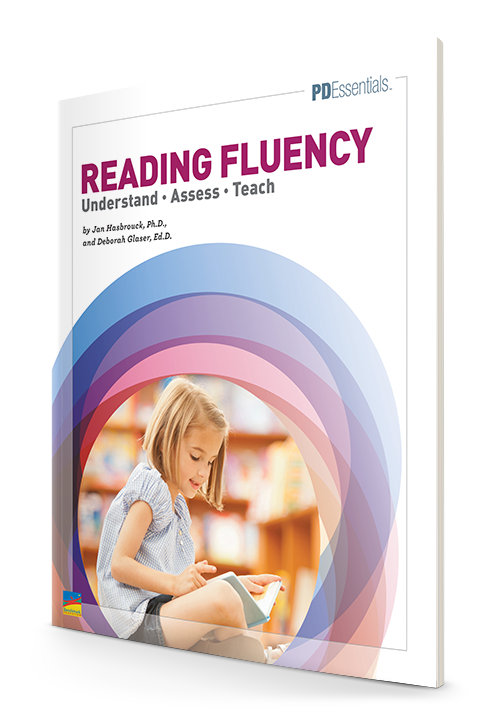Best Practices in Fluency Development

What is Fluency?
Fluency is the ability to read “quickly, effortlessly, and efficiently with good, meaningful expression” (Rasinski, 2003). Fluency includes three main components:
-
Word recognition is identifying words accurately and quickly.
-
Decoding is the ability to figure out unknown words.
-
Prosody is the use of stress or emphasis, pitch or intonation, tempo or rate, the rhythmic or regularly reoccurring patterns of language, and appropriate phrasing (Kuhn, 2003).
Word Recognition
In order for reading to be a pleasurable and meaningful experience, students must acquire an ever-growing core of words that they are able to recognize, identify, and pronounce accurately and quickly. When the majority of needed words fall into this category, the reader is approaching the fluency goal of automaticity.
High-frequency words and phrases are those most often used in texts. Sight words are those that do not lend themselves to decoding strategies. Continued exposure to high-frequency and sight words provides students a chance to internalize them, move toward automaticity, and utilize their energies for constructing meaning.
Decoding
All readers encounter words from time to time that require decoding. In order to be fluent readers, students must be able to efficiently determine the pronunciation of unknown words “on the run.” By developing increasingly complex word-solving skills, decoding becomes less laborious—and therefore less of an interruption—and moves students even further toward automaticity. Again, this allows readers to direct their attention to the text's meaning.
Successful reading demands a certain level of accuracy in decoding words (Rasinski, 2003). In order for a text to be in the instructional zone, readers should be able to recognize or decode 90–95% of the words. If the reader makes more than ten decoding errors for every 100 words, the text is likely too difficult, often called the frustrational zone. Always select texts in the easy or instructional zone for students who are working to improve fluency.
Prosody
Prosody is often referred to as “reading with expression” and dramatically increases both enjoyment and comprehension of a text. Teachers encourage their students to read with expression, but what exactly does that mean? Expression utilizes emphasis, intonation, rate, language patterns, and phrasing, and does not always occur during the first reading of the text. Accomplished, fluent readers often revisit a sentence to monitor and adjust expression and repair comprehension. The key to prosodic reading is to understand the connection between spoken and written language. Following are three key considerations:
-
Before-reading activities, such as activating prior knowledge, help support prosody. With a clear understanding of the setting, characters, and purpose of the text, the reader can visualize how a selected portion should be read.
-
Repeated readings with discussion in between also help develop expressive reading. Insights gained during these activities cause students to consider the emotional impact of the text within their schema.
-
The greatest determining factor when developing prosody is modeling, which may occur during a read-aloud, shared reading, or paired reading. By hearing your interpretation of the text, students can continue to process their thoughts and emotions and apply them to their own versions of expression.
Reading Rates
Oral reading rates are one way to assess and document fluency. If a reader exhibits fluency while reading orally, we can infer that he is fluent when reading silently. The chart below provides an approximate range for words-per-minute in each grade level.
| Grade | WPM |
|---|---|
| 1 | 60–90 |
| 2 | 85–120 |
| 3 | 115–140 |
| 4 | 140–170 |
| 5 | 170–195 |
| 6 | 195–220 |
| 7 | 215–245 |
| 8 | 235–270 |
Speed alone, however, does not equal fluency. Accuracy, phrasing, and intonation must be considered as well. Oral reading rates will vary as content changes, motivation and interests change, and background knowledge grows. Johnston (1997) says, “Without consideration of the kinds of words, familiarity of the material, and kind of reading being done, it is difficult to know what reading rate means.”
Effects on Comprehension
Since reading involves two interdependent tasks—decoding the words on the page and making sense of the words being read—fluency plays a role in comprehension. Meaning helps students maintain fluency, and fluency helps students monitor for meaning.
As we have seen, the first criterion is automaticity, the ability to recognize words without constant decoding. Spending too much time attending to decoding causes comprehension to falter. The second criterion is prosody. Making written language sound like oral language provides clues to a text's meaning, indicating ongoing comprehension. A reader can apply appropriate phrasing and expression only through understanding what is being read.
Instructional Implications
Fluency instruction is not taught in isolation. It is integrated into the entire literacy curriculum. From read-alouds to independent reading, teachers must provide students opportunities to develop automatic and expressive reading. Even when instruction highlights fluency, the modeling, prompts, and practice all focus on making meaning and getting enjoyment from the reading process. Following are some specific practices that are particularly important to fluency acquisition:
Read-Alouds
By reading aloud, teachers:
-
Model fluency by showing students how a proficient reader grapples with text
-
Build motivation by demonstrating what an emotionally powerful experience reading can be
-
Build background knowledge of book language
-
Make a statement that reading is a valuable use of time
By listening to read-alouds, students:
-
See first-hand the impact a well-written text can have on a reader
-
Develop an awareness of narrative and informational text structures that support comprehension
-
Are exposed to multiple genres at more difficult reading levels than they might normally explore on their own
An alternate version of read-alouds, with many of the same benefits, is to utilize a listening center in which students can hear fluent reading while following along in the text. Ask your library media specialist for audio books that support the content areas and are thematically linked to your current units of instruction.
Shared-Reading
Shared-reading—in which the text is displayed for all to see using a big book, chalkboard, chart, or overhead—provides another strong model for students. Shared-reading scaffolds fluency in three ways:
-
It helps students process visual information rapidly through a focus on high-frequency words and sight words.
-
It provides an opportunity for teacher think-alouds and student practice in decoding strategies.
-
It provides students a model for automatic, expressive reading through listening to the teacher and practicing chorally with classmates.
A genre that is particularly conducive to shared reading is poetry, which is written to be read aloud. The rhyme, rhythm, and repetition of poetry, introduced in a shared-reading setting, support students' developing fluency, build vocabulary, and serve as a model for descriptive writing.
Repeated Readings
As mentioned earlier, reading texts many times over is a key fluency tool. Repeated readings:
-
Promote faster reading with greater word recognition
-
Help students break out of word-by-word reading
-
Increase comprehension
-
Help readers recall facts and important information
Small-Group Instruction
During small-group instruction, students meet together to share a common text at an instructional reading level. The text is revisited over several sessions, therefore encouraging repeated readings. Completed texts are then placed in individual book boxes for students to re-examine at a later date, allowing for even more fluency development.
Buddy Reading
In buddy reading, a student pairs up with a classmate at a similar reading level. Partners decide together how they will orally read the selected text—such as trading off by paragraphs, pages, or sections—and stop periodically to discuss what they have read and ask each other questions. To end the session, they agree on an independent reading assignment to complete at home. The next day, the partners discuss that portion of the text and continue the buddy-reading process.
Independent Reading
In What Really Matters for Struggling Readers, Allington says that the key to developing fluency is finding authentic purposes for students to practice in an uninterrupted reading environment with access to appropriately leveled texts. Independent reading of easy texts gives students time to practice the skills and strategies they are learning, contributing to fluent, expressive reading.
Reader's Theater
Reader's Theater is a rehearsed, oral interpretation of a text before an audience. Reader's Theater can add variety, fun, interest, and purpose to reading, as well as:
-
Improve oral fluency
-
Increase silent reading and tracking skills
-
Develop listening skills
-
Provide motivation to read and reread
-
Develop confidence and self-image
-
Portray character traits through voice, mood, and expression
-
Stimulate imagination
-
Teach new facts and content knowledge
What Next?
Join Deborah Glaser, Ed.D. for an on-demand PD webinar, Reading Fluency: The Ultimate Goal of Reading Instruction. This webinar explores what it means to read fluently, and how this goal of reading impacts our instruction. Attendees will take away renewed understanding of their students’ reading fluency and many practice activity ideas that can be easily implemented right away in small-group intervention and during whole-group instruction.
Watch Now →
You May Like: Reading Fluency: Understand – Assess – Teach

















Comments